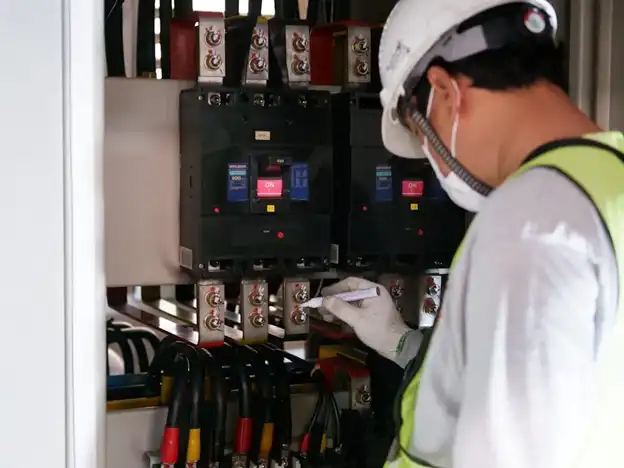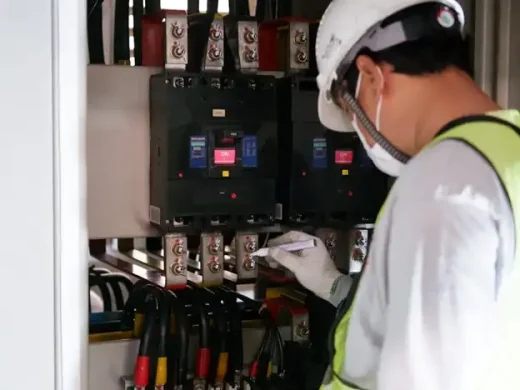Home Electrical Inspection guide, House electrics system hazards advice, Property outlets and switches
Home Electrical Inspection Advice
22 January 2025
What to Expect from a Home Electrical Inspection
A home electrical inspection is your first defense against potential electrical hazards hidden within your walls. This detailed assessment examines every part of your home’s electrical system, from the main service panel to individual outlets and switches.
Think of an electrical inspection as a health check-up for your home’s nervous system. Licensed inspectors carefully check the following:
- Wiring conditions and connections
- Circuit breaker functionality
- Outlet safety and grounding
- Electrical panel integrity
- Safety device operations
Your family’s safety is at risk when electrical systems are improperly maintained. Faulty wiring is one of the leading causes of residential fires, resulting in thousands of incidents each year. Regular electrical inspections help find potential dangers before they turn into life-threatening situations.
A thorough inspection ensures your home meets current safety codes while safeguarding your investment. Whether buying a new home, renovating, or maintaining an older property, scheduling regular electrical inspections creates a safer living environment for everyone in your household.
Understanding the Electrical Inspection Process
Licensed professionals conduct a home electrical inspection evaluating your residential electrical system. These inspections are critical diagnostic tools for identifying potential hazards, code violations, and maintenance needs within your home’s electrical infrastructure.
The electrical inspection in St Louis or any other city in the United States follows a structured approach:
1. Initial Assessment
- Review of electrical service panel location
- Documentation of system specifications
- Identification of previous modifications
2. Physical Examination
- Inspection of the main electrical panel
- Assessment of circuit breakers and fuses
- Evaluation of wiring conditions
- Testing of outlets and switches
3. Safety Verification
- Measurement of voltage levels
- Check for proper grounding
- Identification of fire hazards
- Verification of surge protection
4. Documentation
- Detailed notes on findings
- Photos of problem areas
- List of code violations
- Recommendations for repairs
Licensed inspectors use specialized equipment to test electrical components, including multimeters for voltage readings and thermal imaging cameras to detect hot spots in wiring. They examine both visible components and access points behind walls or in crawl spaces to ensure a thorough evaluation of your home’s electrical system.
The process typically takes 2-4 hours, depending on your home’s size and system complexity. Your inspector will document all findings in a comprehensive report, highlighting immediate safety concerns and potential future issues that require attention.
Common Issues Identified During Electrical Inspections
Professional electrical inspectors frequently discover potentially hazardous issues during their examinations. Here are the most common problems that require immediate attention:
Frayed or Damaged Wiring
This could be due to:
- Exposed copper wires create fire hazards
- Rodent damage compromises wire insulation
- Old wiring deteriorates, leading to short circuits
Overloaded Circuits
- Multiple high-power devices on single circuits
- Extension cords are used as permanent solutions
- Warm outlets or buzzing sounds indicate overload
Faulty Outlets and Switches
- Loose connections cause sparks
- Cracked or broken outlet covers
- Non-functioning or partially working outlets
Improper Wiring Installation
- Reversed polarity in outlets
- Missing junction box covers
- Incorrect wire gauge for circuit amperage
Water-Related Issues
- Corroded electrical panels
- Moisture in outlet boxes
- Water-damaged wiring insulation
These issues create significant safety risks, from electric shocks to potential house fires. Licensed electricians can resolve these problems through:
- Replacing damaged wiring with new, code-compliant cables
- Installing additional circuits to distribute electrical load
- Upgrading outdated outlets and switches
- Proper sealing against water intrusion
- Correcting improper installations to meet current safety standards
Key Components of an Electrical Inspection Checklist
A comprehensive electrical inspection checklist is your roadmap to evaluate your home’s electrical system thoroughly. Professional inspectors follow specific protocols to ensure no critical components are overlooked during the assessment.
Main Service Panel Evaluation
- Proper labeling of circuits
- Secure mounting and accessibility
- Absence of rust or water damage
- Correct breaker sizes for circuits
Wiring Assessment
- Proper wire gauge for each circuit
- Secure connections at terminals
- Appropriate wire routing
- Heat-resistant insulation, where required
Device and Fixture Testing
- Light switch functionality
- Outlet polarity
- Dimmer performance
- Fixture secure mounting
Documentation Requirements:
- Electrical permits
- Previous inspection records
- System modifications history
- Equipment warranties
Voltage Checks and Visual Inspections
Voltage testing represents a critical component of electrical safety verification. Inspectors use specialized equipment to measure:
Voltage Readings
- Line-to-neutral voltage (120V typical)
- Line-to-line voltage (240V typical)
- Ground-to-neutral voltage (should be near 0V)
Visual Inspection Points
- Wire Connections
- Component Condition
- Safety Features
Grounding Verification and Safety Device Testing
Proper grounding serves as your electrical system’s critical safety net. A grounded system directs excess electrical current safely into the earth, protecting you from potentially fatal electric shocks. During an inspection, professionals verify grounding through:
– Resistance Testing: Measuring the ground connection’s impedance to ensure it meets safety standards
– Visual Assessment: Checking ground wire connections at the main panel and subpanels
– Bonding Verification: Confirming metal components are correctly bonded to the grounding system
Ground Fault Circuit Interrupters (GFCIs) add another layer of protection by monitoring electrical current flow. When they sense a ground fault, these devices detect imbalances and cut power within milliseconds.
Benefits of Regular Electrical Inspections
Here are the benefits of regular inspections include:
Protecting Your Home
Your home’s electrical system experiences regular wear and tear. Regular inspections can ensure that it stays in good condition and prevent electrical fires, which are a leading cause of home disasters. Professional inspectors have the trained eye to see things like worn-out insulation, corroded wires, and other fire hazards that may not be obvious to someone without training.
Following Electrical Codes
Staying up-to-date with electrical codes protects your investment and ensures your insurance remains valid. Building codes change over time as new safety standards come into play, and routine inspections can help you:
- Meet current safety requirements
- Maintain the value of your property
- Avoid having your insurance claims denied
- Prevent expensive emergency repairs
Saving Money in the Long Run
Many homeowners find that regular inspections save them money by spotting energy inefficiencies and stopping significant failures in their electrical systems. These preventive actions increase the lifespan of your electrical components and keep everything running smoothly throughout your home’s electrical network.
Home electric maintenance significantly improves overall safety and efficiency. Moreover, following helpful tips for maintaining your electrical system can enhance its longevity and performance.
Home Electrical Inspection Final Thoughts
Home electrical inspections protect your home against potential hazards in your electrical system. These inspections aren’t just another task on your home maintenance list – they’re a crucial investment in your family’s safety and property protection.
Think of electrical inspections as a regular health checkup for your home. Just as you wouldn’t skip your annual medical examination, your home’s electrical system needs the same attention and care.
By scheduling routine inspections, you’re taking proactive steps to prevent electrical fires, avoid expensive repairs, and ensure your home meets current safety standards.
Remember: Your family’s safety is priceless. Don’t wait for electrical issues to arise – schedule your home electrical inspection today!
Comments on the guide to Home Electrical Inspection guide, House electrics system hazards article welcome.
Glasgow Architecture
Major Strathclyde Building Designs – selection:
Historic Glasgow : best Glasgow architecture of the past
Comments / photos for the Home Electrical Inspection guide, House electrics system hazards advice guide page welcome.




